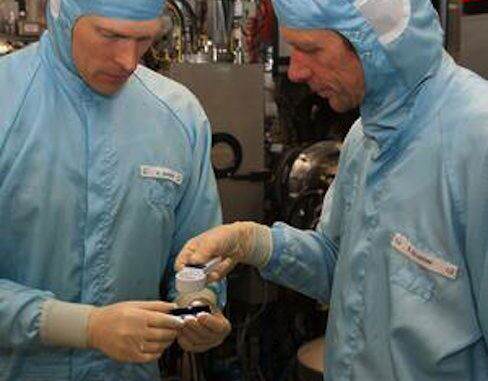
Thin-film photovoltaics achieves 20.8% efficiency and overtakes multicrystalline silicon technology. In the race for higher power yields, the Zentrum für Sonnenenergie- und Wasserstoff-Forschung Baden-Württemberg (Centre for Solar Energy and Hydrogen Research, ZSW) has set a new world record. The Stuttgart researchers have improved the efficiency of CIGS thin-film solar cells to 20.8%.
This figure is a record for converting sunlight into electrical energy and, for the first time, it exceeds the efficiency of market-dominating multicrystalline silicon solar cells. The new research findings from Baden-Württemberg are likely to further reduce the cost of solar power in future.
The record solar cell, made from copper indium gallium diselenide (CIGS), has an area of 0.5 square centimetres – a usual size for experimental cells. It was manufactured in a laboratory coating system using a simultaneous evaporation process, which in principle can be transferred into industrial production processes.
«Our new record shows that CIGS thin-film technology still has untapped technological and economic potential,» says a delighted Prof. Dr. Michael Powalla, board member and head of the photovoltaics division at ZSW.
The success of the Stuttgart-based scientists substantially surpasses their own record for CIGS solar cells of 20.3% on glass. More significantly, however, this value beats the peak performance of 20.4% for multicrystalline silicon cells.
Market-dominating multicrystalline cells have held onto their advantage for nearly 30 years – now CIGS is in the lead. The results have been officially confirmed by the Fraunhofer Institute for Solar Energy Systems ISE.
ZSW is now working to transfer the optimised CIGS process to modules. «It may take a little time for the higher efficiency to be reflected in production,» Powalla notes. «But 16 to 18% in commercial modules is possible over the next few years.»
Market-standard CIGS modules currently attain efficiencies of 14 to 15%- a module always has lower efficiency than an individual solar cell.
ZSW’s success is the result of intensive research activities that have been supported by the German Federal Environment Ministry and the state of Baden-Württemberg for many years. With the recent achievement, the Electronic quality of the solar cell has been enhanced. The world record underscores the state’s capacity for innovation and will help technologies «made in Baden-Württemberg» to compete against Asian rivals. One example is ZSW’s industrial partner Manz AG, based in Reutlingen, which offers a turnkey production line for manufacturing modules using the ZSW technology.
Compared to standard solar cells, thin-film photovoltaics saves materials and energy since the coating used is just micrometres thick. This is a considerable cost reduction factor for future production. The experts all agree that the new record demonstrates the great potential of CIGS technology for even more cost-effective and efficient photovoltaics.
The Zentrum für Sonnenenergie- und Wasserstoff-Forschung Baden-Württemberg (Centre for Solar Energy and Hydrogen Research Baden-Württemberg, ZSW) is one of the leading institutes for applied research in the areas of photovoltaics, renewable fuels, battery technology, fuel cells and energy system analysis. There are currently around 230 scientists, engineers and technicians employed at ZSW’s three locations in Stuttgart, Ulm and Widderstall. In addition there are 120 research and student assistants.
